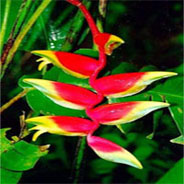|
||||
|---|---|---|---|---|
 |
 |
|||
Joyeux Noël | Buon Natale | Fröhliche Weihnachten | Feliz Natal | Kala Christougenna |
Broken News
Watch Your Stuff in December
December is a big month in Costa Rica for vacationers from far and close. Quepos/Manuel Antonio will get busier and busier as the month proceeds, peaking during the week between Christmas and New Year..
 |
|---|
A "Policia" Dressed in Police Blue for the Season |
The month might also be labeled National Tiquicia Robbery Month as the thieves and pickpockets come out in force. Not only are there a large number of visitors and tourists but most Costa Ricans receive their "aguinaldo", or thirteenth month bonus, in December in time for Christmas. So pickings are rich for the bad guys.
GG says this not idly. I and both of my founding ROMEO brothers have all experienced the lifting, at least twice each, of money clips, cell phones and wallets, mostly in December and usually getting on or getting off the bus. Here are a few tips on keeping your awareness and anticipation high during this period:
Beware the bump or push from behind, Ticos are usually very polite in bus lines and anyone pushing hard or bumping strongly is likely not just being rude but more likely setting you up for a lift you can't feel.
Don't be naive enough to think that because the pocket on your shorts has a velcro , button or snap closure that your stuff will be safe. You won't even feel the difference when bumped. Both velcro and snap closures were easily violated in the ROMEO thefts. Keep stuff in a zippered backpack or other closure device that isn't easily opened - keep the pack in your lap on a bus.
Don't flash your wallet and/or money around crowded public areas. That just tells the thief where you store your stuff when you return it to your pocket or bag so they can plan where to heist it from you without having to guess its location. This is exactly what happened to GG at the Quepos bus station boarding a bus to San José. The wallet had 60,000 colones and $80 U.S. in it, an expensive lesson.
I now have a waist purse at the suggestion of my landlady (I call it my chastity belt) that I wear constantly and which, I feel, gives me a better degree of safety. But I also know that there have been robber teams in San José that combine the bump with a quick knife to cut the belt and make off with the stuff.
Make copies of the identification page of your passport and other picture ID's and leave the originals in a hotel safe or other secure location when you go to the beach or shopping. Take only the amount of money and one credit/debit card to get you through the day. Leave the rest in a secure place.
Never, never. never leave valuables unattended at the beach. My good friend Paluca, purveyor of umbrellas and beach chairs at Mar y Sombra taught me to twist-tie my backpack around the support arms of the beach umbrella. If a thief tried to steal away quickly with the pack he'd quickly get entangled in the umbrella.
The police try to increase their awareness and patrols during the high season but the task is monumental because of the numbers of people involved and availability of so many targets. There is much to enjoy here and most likely the period will be incident free but it is always good to practice a milligram of prevention - it's worth a kilo of cure.
In December of 2010 the Chronicles reported (Rank Ranking) that the World Bank rated Costa Rica for 2011 as #125 out of 183 countries in their "Ease of Doing Business Index".
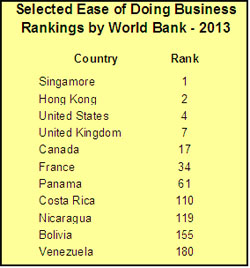 |
|---|
They recently reported that Ticoland has improved 15 positions since then to 110 for the year 2013. While this is definitely an improvement, the overall number is still not good, expecially for a democratic country aspiring to develop its economy into an efficient, modern state.
The World Bank uses 10 criteria to determine the overall ranking; they are (the numbers in parentheses are for Costa Rica): 1. Starting a Business (128), 2. Dealing With Construction Permits (128), 3. Getting Electricity (45), 4. Registering Property (46), 5. Getting Credit (83), 6. Protecting Investors (169), 7. Paying Taxes (125), 8. Trading Across Borders (51), 9. Enforcing Contracts (128) and 10. Resolving Insolvency (128).
Costa Rica exceeds the median (93). i.e., it's in the top half of all countries in only four of the criteria: Getting Electricity (45), Registering Property (46), Getting Credit (83) and Trading Across Borders (51). It's worst ranking, Protecting Investors (169), is near the bottom for all countries (just ask people who invested with the Villalobos boys about that).
Yet the trend is in the right direction and, hopefully will continue at least until Tiquicia can say it's running ahead of such world-class economies as Sri Lanka and Greece, which currently are ahead of us.
Confounded Celibacy
Sometimes a headline in the media carries a message just too poignant to pass over and brings a devilish smile to one's face. So it was with me when I recently saw the following headline in an electronic newsletter:
"Sect that practiced celibacy
dwindles to a few members"
Da, do ya think? What the article was referring to was the plight of the Shaker communities in the U.S. There are still more than a dozen of these spartan communities in the northeast and midwest but their numbers are declining as their recruitment of new members from the outside is not keeping up with normal mortal attrition. They hit a peak of around 6,000 members in the 1800's but are now down to less than 1,000. Committed to self-imposed celibacy, their hope for internal regeneration to augment outside recruiting is not the best.
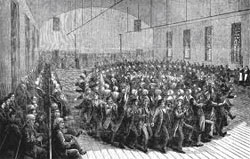 |
|---|
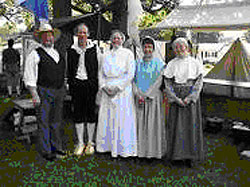 |
Early Shaker Meeting (top) and Some Modern Shakers (bottom) |
The Shakers , officially the United Society of Believers in Christ’s Second Appearing, were formed in the late 1700's to provide believers with a simple and ascetic lifestyle. In pursuit of that practice they use plain, modest dress, keep basic, simple households and attend prayer meetings regularly. While similar to the Mennonites or PA Dutch in that regard, they are known to be a little more liberal in the use of modern products and devices like appliances and cars.
And there social life also is a bit more liberal. They believe in vigorous dancing at their meetings (hence the name 'Shakers'). They even tolerate moderate use of alcohol products (I would think it would be more than moderate when combined with required celibacy). Shakers also had a strong belief in gender equality long before women's lib arrived on the scene.
To support their communities they produce furniture products and run novelty shops offering their home made products and a variety of garden seeds that have a high quality reputation. I've seen their products in Pennsylvania and they deserve their good reputation.
But, of course, they are most known for their practice of celibacy. Men and women live together as brothers and sisters but intimate relationships or marriage is not permitted. I don't know if the Shakers would find any solace in the knowledge that the number of nuns and priests, who also are required to practice celibacy, has declined dramatically in the last few decades. Celibacy evidently is not as attractive as it used to be (nor is personal committment to sacrifice).
To my knowledge there are no Shaker communities in Costa Rica. We do, however, have a very active Mennonite community in San Isidro, not too far from Quepos. I see them at the feria (farmer's market) virtually every week. I've met a few of them and they are warm and friendly people.
My only beef with the Mennonites at the feria is that they offer a series of bakery products that put the agreement I have with my doctor in serious jeopardy.
¡Solo Bueno, Muchachos!
Rumble Talk
(Tidings of Tremors on the Pacific Rim)
No Let Up in Tremors
The year 2012 in Costa Rica might better be named the year of the tremor.
Right after the major 7.6 Richter earthquake near the town of Nosara in the Nicoya peninsula on September 5, scientists warned us that only about 50% of the energy that could have been released actually was. They know this by measuring the movement of the Coco and Caribbean tectonic plates that come together under the country. It was these plates that caused the development of the original central american isthmus and the spine of mountains that runs down the center of Costa Rica, which also includes several active volcanoes.
The scientists were right. We have since been subjected to regular, even daily, tremors of varying magnitude. There have been literally hundreds of minor aftershocks in the 2-4 Richter range. And on October 8, a month after the big one, GG was subjected to a short but sizable quake (5.8) while sitting on Manuel Antonio beach. Then, in the early evening of October 23rd a 6.6 "shadow" quake (one that mirrors the strength and length of another, in this case the big one) hit near the same epicenter as the big one, shaking most of Costa Rica and bringing the already weakened and abandoned Puntarenas Hospital into further concern.
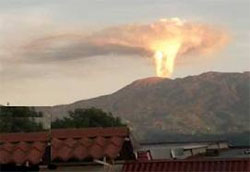 |
|---|
An Old Photo of A Previous Eruption at Volcan Turrialba |
New warnings have become common place in the weeks following he big one in September and new cautionaries are being issued weekly, sometimes daily. In October, Volcan Poas started spewing stuff from it's acidic lake. The material didn't leave the caldera but did coat it's sides with a distinctive pattern.of sediment and sulphur. The link between tremors and volcanic activity continues to be demonstrated throughout the region.
In early November, the government declared people in a two kilometer radius of the crater at Turrialba volcano "at risk" for an eruption, urging the populace to abandon cattle grazing and farming within that zone. The town of Turrialba covers in excess of 50,000 people and is only about 30 kilometers from San José as the pelican flies.The federales have alrady begun joint exercises with the local and canton governments for emergency evacuation if needed.
So stay tuned as this soap opera continues to unravel. At this time GG and friends have not cancelled plans for our End of the World Party on December 21 in Manuel Antonio, the date which coincides with the Mayan prediction of pending armageddon.
If you do not receive your January issue of the Chronicles in late December or early January you might want to inquire if GG has gone Mayan.
Guatemala Too
Chalk up one more for the Cocos and Caribbean tectonic plates. These are the plates that run under Central Ameica and which, a few million years ago, originally formed the narrow isthmus that now comprises the six countries in the region (Guatemala, Honduras, Belize, Nicaragua, Costa Rica and Panama).
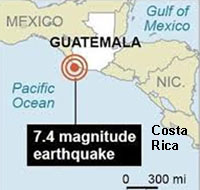 |
|---|
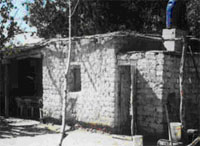 |
| Adobe House |
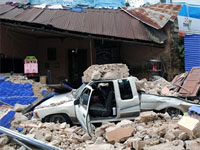 |
| Truck Resale Value Lowered |
These are the same plates that slipped and caused the huge quake in the Nicoya peninsula of Costa Rica in early September of this year that interrupted a visit by GG to the Puntarenas Hospital for an eye exam..
On November 7, 2012 these plates slipped again and produced a strong tremor about 30 miles off the Pacific coast of Guatemala and caused great damage in cities near the coast. Some 50 people were killed, hundreds injured and thousdands displaced.
The Richter value of the Guatemala tremor, at 7.4, was actually a couple of tenths of a point lower than the Nicoya terremoto but the bad results were much worse. Why?
As mentioned in the article in the October Edition, there are three things that contribute to the severity of damage: 1) surface proximity to the epicenter (the Guatemala quake was about the same distance off shore as the Nicoya tremor center was to Puntarenas), 2) the depth of the tremor (Guatemala was shallower at 24 km down than the Nicoya which was 41 km below the surface) and 3) the lind of construction prevalent in the quake area.
Unfortunately, the type of construction or its degree of earthquake resistence is much poorer in many parts of Central America than it is in Costa Rica, probably a direct reflection of the difference in affluence between Costa Rica and much of the rest of Central America. Such was the case in Guatemala where adobe type construction has been widely used.
Adobe style construction has been around since man got tired of living in caves, at least since 8,000 B.C. Adobe mud blocks are the cheapest way to build a home or building and use local earth to make the large blocks or bricks that serve to build walls; walls which are unsteady in a tremor yet quite heavy enough to do great damage when they collapse. Typical cost of construction by the Adobe method is in the $10-20 per square meter range while average consruction cost in the U.S. is about $850 per square meter (1 Sq meter = approx. 10.5 square feet)
Estimates are that approximately 50% of people in developing countries and 30% worldwide live in houses of adobe type construction. The difference between what happened in Guatemala and what happened in Costa Rica in similarly strong earthquakes can be attributed directly to the type of construction and indirectly to the level of economic development of the two countries.
Dios te Bendigo, amigos de Guatemala, God be with you.
Get it Right, Or Else
This is not about the Pacific Rim but the story may portend the way things are going to be in earthquake-prone areas in the future. Hopefully not.
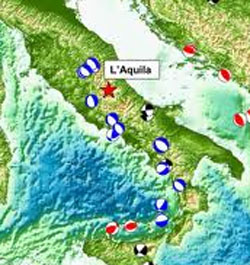 |
|---|
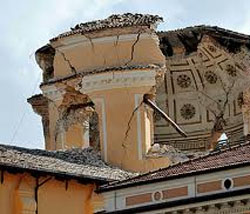 |
The Dome of the Town Cathedral was Utterly Destroyed |
Italy, another mountainous, volcano-dotted and frequent earthquake region had a major tremor in the town of L'Aquila in 2009. L'Aquila (which means The Eagle) is a town of about 75,000 located approximately 100 kilometers north-northeast of Rome. L'Aqiula is the capital of the Abruzzo region, in the heart of the Appenine Mountains.
The quake that hit in L'Aquila on April 6, 2009 was measured at 5.8 on the Richter scale, severly damaged many buildings and accounted for 308 deaths and thousands of homeless. Pictures of the damage seemed to back up scientists claims that shoddy construction (read adobe-type clay) was a major factor in the disaster. Nevertheless there was also significant damage to stronger buildings like the cathedral which was virtually demolished.
The unusual thing about this story is not the human tragedy that occurred but what happened later. Some months after the event a total of six scientists and one government official, members of what was called a "Risk Assessment Panel" were arrested and eventually brought to trial in September of 2011 for not giving the populace early warning and ""incomplete, imprecise and contradictory information about the quake leading to manslaughter".
On October 22 of this year the seven were found guilty as charged and each sentenced to six years in prison. As might be expected, the trial and sentence caused an uproar among the international scientific community. There remains no reliable predictor of earthquakes, say the experts.
Dude, the absence of such predictions is a good sign it's not yet possible. Of course, there are ongoing attempts to relate changes in pre-quake seismic waves to actual major quakes but no model for prediction has yet to be developed other than one that gives only a 10 to 60 second warning..
What was that about killing the messenger with the bad news? Scientists around the world have stated that this trial and its outcome will put a damper on scientists being willing to share information they gather.
Ya think?
Christmas in Costa Rica
(Sunny Days, Mucho Festivales & Parades, Tamales & Pork Leg)
December in Costa Rica is a very active month for both residents and visitors, The beginning of the month brings on the end of the rainy season and the onset of long, sunny days. That's not to say that the rainy season has short days as the hours of light here throuhout the year are virtually the same, varying by no more than 15 minutes over the twelve months. That's what happens when you live close to the equator (9º latitude).
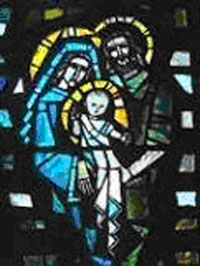 |
|---|
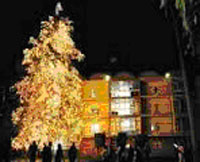 |
A Tree in the Big City |
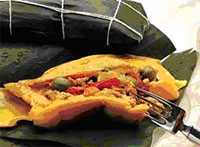 |
A Christmas Tamal |
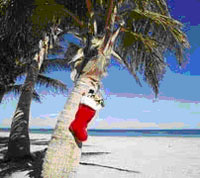 |
|---|
... the Stockings Were Hung by the Palm Tree With Care. |
 |
Suggested Christmas
Week
Attire at Manuel Antonio |
 |
One Way to Work Off Christmas Dinner |
There is more emphasis here on the religious aspects of christmasthan, say, in the U.S. Oh yes there's plenty of time for festivals and parties but there also is great emphasis on the true meaning of the day.
Many families construct a portal (pronounced por-tahl with the emphasis on the second syllable), which is what some other cultures refer to as a nativity scene or maybe even a crèche (particularly among those of french heritage like GG). Families are very proud of these displays and they may contain a large number of artistic and heirloom pieces.
Many catholic families attend midnight mass called La Misa del Gallo or Mass of the Rooster. For little children, presents are not brought by Santa Claus but instead by Baby Jesus on Christmas Eve (Noche Buena).
On Christmas Eve, families gather for a traditional meal, the focus of which is a leg of pork and the tamal. I've had these corn or maize based tamales, stuffed with pork, beef or chicken, potatoes, rice, garlic and more in the past and they are truly delicious.
For a real Costa Rican tamales recipe go here: Tamal.
The week between Christmas and New Year's is the busiest week of the year for the resort industry here. The calendar has entered the high season (actually, the high-high season) and there are many gringo and other tourists in the area. In addition, the week is a traditional vacation time for Ticos so many families and singles from the central valley and other inland points head for the beach. The water will be 80-85ºF and the days will usually be sunny all day long.
I have to admit that the local beach is not my favorite place to go during Christmas week; I tend to avoid it because of the crowds. It's not as bad as the New Jersey shore on Labor Day but not far from it either. One week later, everything returns to relative normalcy.
There are many festivals and parades all over the country but the most and the biggest are in San José, There you'll find horse parades, night festivals of light and the traditional taunting... er, excuse me, running of the bulls.
Go here to see More on Christmas Traditions and Festivals in Costa Rica.
¡Feliz Navidad a Mi Familia y Todos Mis Amigos!
Nick at Night
(Sugar Plums and Saints)
St. Nicholas, Kris Kringle, Sinter Klaas, Father Christmas, Santa Claus; these are all familiar terms used around the world to describe the character that is the spirit of Christmas.
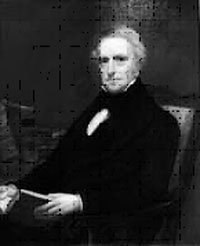 |
|---|
Clement C. Moore - "Visions of Sugar Plums Danced in Their Heads" |
In Costa Rica, because Baby Jesus (rather than Santa Claus) is appointed to deliver presents to children, the familar north american icon of the jolly old fat man in fur-trimmed red clothes sporting a long white beard and a pot belly is not seen here too often. That image was invented or first described by a gringo named Clement C. Moore in 1822 when he wrote the poem "''Account of a Visit from St. Nicholas" better known as a The Night Before Christmas.
Moore was the son of a preacher, grew up as an only child in a wealthy New York City family, grabbed M.A. and LL.D. degrees from Columbia and became a professor of classical studies at Chelsea Theological Seminary to which he later endowed a goodly portion of his inherited estate. Prior to writing The Night Before Christmas, he wrote such exciting tomes as A Compendious Lexicon of the Hebrew Language (1809) and a translation of A Complete Treatise on Merinos and Other Sheep (1811) from the original French.
Moore was a stern, dour individual and the departure from his own life style to write the light and whimsical christmas poem, which was unlike the tenor of his previous works, suggest to some that he was not the real author of The Night. However, there is no direct evidence that he wasn't, so he's gone down in history as the original author.
 |
|---|
St. Nicholas With Children |
Whether it's Santa Claus or Kris Kringle or any of the others, the original inspiration for the Christmas figure, one celebrated around the world and particularly in latino countries is St. Nicholas, a third century Greek (260-343 AD) born in what is now Turkey in a town called Patara.
Like Moore, Nicholas grew up in a wealthy family and also like Moore, he was imbued with strong religious beliefs at an early age. His feast day is celebrated on December 6 and marks the beginning of the Christmas month which culminates with the Epiphany on January 6. Nicholas' parents died when he was young and the future saint quickly started to use the wealth of his inheritance for the benefit of others.
As soon as he inherited it, Nicholas began distributing his wealth to help the poor, particularly children of a young age. He became a bishop as a young man. This was a time of severe persecution of christians by the Romans and he was imprisoned and severely tortured as were many other Christians during that period.
One of the more interesting parts of his story is about the way he sometimes delivered his help. It's told that he would slip by windows of poor houses and pitch some money through an open window or slip in quietly and put money into a shoe or stocking. This may very well be the origin of both the traditions of gift-bearing by a secret visitor as well as stuffing a stocking with goodies.
My stocking's up (on the palm tree); come on Nicky!
¿Who Is Manuel Antonio?
(Will the Real Manuel Antonio Please Stand Up)
Note: Further information on the history of the area contained in this article was developed after it's publication and may be found at: More on Manuel Antonio.
Google "Manuel Antonio" and you'll get a thousand references about how beautiful the area and national park are (Forbes rated it as one of the 12 most beautiful parks in the world), followed by another thousand references about where to stay and what to do when you're here. Google "Manuel Antonio, the man" or "Who was Manuel Antonio" and you'll get exactly the same stuff.
What!? Who was this dude?
I've been coming to this area for nine years and living here for four. I'm a little slow, which sometimes works well in this area, but when I asked the question "Who was Manuel Antonio?" I got back blank stares, mumbling and several expletives deleted.
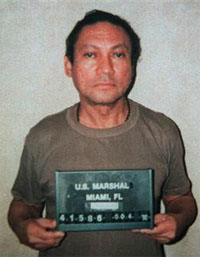 |
|---|
| Another Manuel Antonio - Would You Buy a Used Country from This Fellow? |
Some people and references say there was no Manuel Antonio (kind of a "Who is John Galt" thing, like in Ayn Rand's Atlas Shrugged). We know that he wasn't a previous president and that he wasn't a hero like Juan Santamaria. Others have suggested, because the area has a large gay population, that the area was originally named Manuel and Antonio.
But who was the real Manuel Antonio? Did he exist? Inquiring minds want to know.
Oh yeah, Googling will get you references to quite a few obscure historical figures from Spain or South America (Manuel Antonio de Molina for example) because Manuel and Antonio are rather common names and often used together. Among the more colorful people you'll turn up in a search is Manuel Antonio Noriega Moreno, the former dictator of Panama now jailed in Florida; I doubt the park was named after him. But there is nothing that links the name to a local man.
Here are some things we know about area history:
- The Quepos/Manuel Antonio area was occupied, before any Spanish got here, by the Quepoa indians (hence the town name), a group that had split off from the Barucas in Columbia and probably arrived here around 900 A.D. They had a reputation for ferocity, including the women, who fought along side the men and were reported to be even fiercer than the men (there were women in my family like that too). The Quepoa were eventually wiped out by the Spanish in the post-Columbian period.
-
Christopher (Manuel Antonio) Columbus was the first European to come to Costa Rica, and on his second visit in 1502 at Limón on the caribbean side, he reportedly coined the term Costa Rica because of the abundant and verdant richness of the jungle-like coast. Chris never got to the west coast, however. (OK, so Chris didn't really have a middle name, of record anyway - I'll fess up)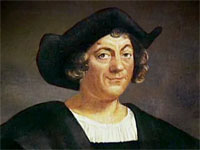
Chris C.
-
Juan Ponce de (Manuel Antonio) Leon got around more than Columbus (i.e., round the Horn I guess). In 1520 he sailed into the local waters of Quepos/Manuel Antonio but reports say he didn't land, evidently a bit cautious of the not too friendly Quepoas. Ponce is credited with putting the area on the map. This is the same dude that claimed Florida for Spain and founded the first permanent settlement in what is now the continental United States, in St. Augustine in 1513.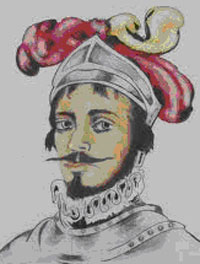
Ponce de Leon - Someone Dressed Like This Shouldn't Land Anywhere 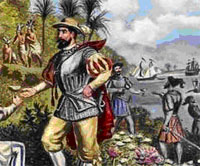
Ponce de Leon Checking Room Availability in Manuel Antonio
-
Costa Rica was largely ignored by the Spanish as a jungle wasteland for nearly 50 years but in 1565, Juan Vázquez (Manuel Antonio) de Coronado was appointed the first Adelantado, or military governor of Costa Rica. The Spanish Viceroys based in Guatemala City and their conquistadors ruled Costa Rica until 1821 when Costa Rica, along with the rest of latin america, declared their independence from Spain. After that, and a short stint as part of the United States of Central America, Costa Rica remained a self-governing state until the foundation of the Democratic Republic in 1949.
OK, so all these guys like Columbus, de Leon and Coronodo were not really Manuel Antonios, but the name turns out to be frustratingly common in the Spanish world. Researching the internet did not reveal who the real McCoy was for the park. There are numerous references, chiefly on tourist web sites, that Manuel Antonio is named after a conquistador who's buried in the park..
It's amazing how false legends grow because people repeat what they've heard or read as being true. Since a conquistador would have had to have been preserved intact from sometime before 1821 and then the remains carefully re-interred from somewhere in the latino world into the park, which didn't open until 1972, the conquistador theory seems dubious. No one I've talked to can substantiate that theory.
There being no limit to the willingness of the Chronicles Research Department (guess who that is) to get to the truth, I decided to inquire further. A trip to MA Park resulted in an interview with a National Park guide named Carlos (Manuel Antonio) Something, who grew up in Quepos and who, sadly, had recently lost his grandmother. His abuela also lived her entire life in Quepos/MA and died at the age of 112 (it's that gallo pinto that does it). "Where is the grave site of Manuel Antonio?", says I. "Which one?", says Carlos. Hmmmm. A second trip and interview with three beautiful young park entrance attendants, as well as a gentleman that worked in the park office. produced no new information, but the office dude did confirm some recent history.
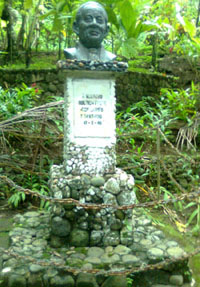 |
|---|
| Manuel Antonio Ramirez, Esq. |
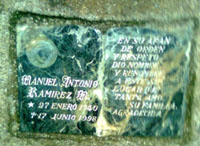 |
| Plaque - "Querido Padre" |
After the Columbian period, the hill now known as Manuel Antonio (previously called Quepos), including the present park land, was thinly populated until the mid-1900's when a number of squatters moved in. Some of them eventually acquired enough property in Manuel Antonio to become rich and legendary here. Then, in the late sixties, a Frenchman (or Frenchmen) bought the property containing the present park from a norteamericano with the intention of developing it into residential real estate. They restricted access to the local beaches by fencing in the area.
All beaches are deemed public property in Costa Rica and the closing of the beaches in Manuel Antonio around 1970 resulted in an "uprising" among the local populace. A group of about 30 angry locals, seventeen of them named Manuel Antonio, stormed the beach barricades, an act which got the notice of the government. San José quickly expropriated the land on which the park is now built (it's not clear if the Frenchies were compensated or not). Not long after the expropriation the land was designated as a National Park and opened to the public in 1972.
One of the ring leaders of the uprising was a gent and store owner named Manuel Antonio (of course) Ramirez M. His store was on the edge of the land in question, an area now known as Mar y Sombra. If you go about a half mile towards Quepos from the park entrance on the main road, you arrive at May Y Sombra. You will see an unobtrusive bust of Señor Ramirez there which is set back under the trees along the semi-circular beach access road. The inscription calls him "dear father" and founder of the area.
So, I'm sorry to report that there is no conquistador buried in Manuel Antonio park, nor was it named after a national hero. The real hero was a local one, a shopkeeper and was the likely namesake of the park. Pura Vida, Manny!
Moral of the story? Never try to block a beach goer from the sun and sand. There will be uprisings.
Reported by: Don Roberto Alejandro (Manuel Antonio) Normando Ramirez
There have been further clarifications on this story since it was written. See More on Manuel Antonio.
What's-in-a-Word
Conquistador (con kees ta door)
Literally translated this means "conqueror". It was a name given to explorers, usually funded by the Spanish court, during the age of exploration 1500's, 1600's and 1700's.This was an age when Spain was a superpower, the court was rich (a lot of it from plunder) and they sent out the brave hearted to all corners of the world expecting a return on their investment (gold and more plunder). You didn't even need to be Spanish to win the favor of the Spanish King; Fernando Magellan (a Portuguese) and Christopher Columbus (an Italian) are examples.
The conquistadors were often military men and traveled with small armies. With their superior weapons they could easily overcome the indian tribes they encountered. Their nobility and adventurousness often led them to be appointed governors over vast territories. Costa Rica was ruled for a couple of hundred years by the conquistadors in Guatemala City where the Viceroy for Central America was based.
Some of the more famous conquistadors were Hernando Cortes, Francisco Pizarro, Hernando De Soto, Vasco Nunez de Balboa, Francisco Vasquez de Coronado and Juan Ponce de Leon.
ROMEO Corner
(Retired Old Men Eating Out)
New this month: The ROMEO rating system this month introduces a "Value Index" which is an attempt to measure the quality of the experience encountered versus the amount of money spent, a "bang for the buck" if you will. The index is calculated by dividing the number of sloths rated by the number of dollars in the cost rating and then multiplying by 100. For more on this rating as well as a comparison of the restaurants rated to date, go to the Restaurant Archives.
La Bohemia
Update February 2013: (La Bohemia was closed in late 2012. Owner/chef Marjorie will be opening a new version of her work in Quepos in coming months.
Location: Downtown Quepos on the same street as Miguelito's Pizza and just across the street
from the Municipal Wood Pile (don't ask). The owner advised that they will be moving to a
new unspecified location sometime sometime in December 2012
Hours: Lunch and Dinner
Parking: On street parking, normally not a problem.
Contact: Tel.: 2774-0109
Reviewing ROMEOS: John S., Bob N.
To Review Our Rating System and Procedure, go here: R.O.M.E.O. Rating System
Good things come in small packages proclaims the old saying. La Bohemia proves that the saying holds true for restaurants as well.
This is one of the smallest restaurants in the area and consists of three tables in the front dining area bordering the street plus two more tables in an additional dining space beyond the kitchen. Total seating capacity is approximately 18. The rooms telescope from the front dining room through the kitchen into the second dining room and finally into the baño. We both remarked that the bathroom was decorated like the anteroom to a French house of ill repute, adding a certain charm to the place.
This is the fourth or fifth time that GG has eaten here and every time the experience has been pleasant. The chef/owner, Marjorie, is a perky Tica that knows how to cook and produces some of the tastiest dishes from the tiniest kitchen yet manages to impose her personal accents on the fare. The menu written on the blackboards posted about the dining room offers a wide variety of items including chicken, seafood, pasta and some Mexican-like specialties such as burritos and fajitas (but those too have a Marjorie flair). There was also a hand written menu of daily specials.
From the specials menu GG chose a seared tuna steak finished with what appeared to be sauteed onions and spices of unknown origin (*ingredientes secretos" or secret ingredients says Marjorie). It was an unusual flavor, a bit spicy and just downright good. The platter on which it was served included a small mixed salad and a pile of mixed vegetables done "au point" as the French say or just barely tender with a crisp edge. My dining companion chose a simple plate of fajitas that came as colorfully decorated as the tuna dish and contained sauteed chicken in a barbecue like sauce. My friend, being a fan of picante flavors asked for an extra something to boost the heat and got a small dish of red peppers in oil that caused even his well tested palate pause. The desert offering was limited but GG had some plain, very rich, vanilla ice cream with chocolate sauce while my friend had a crepe filled with ice cream and topped with chunks of fresh fruit. |
 |
|---|---|
$$$ 1/2 |
|
Value Index = 114 |
Service was attentive and friendly from Marjorie (don'y know how she manages to cook at the same time). For ambiance, food quality and service we give La Bohemia four sloths.
My tuna dish, desert and soft drink came to just about 10,000 colones or $20, including tax. My friends meal came in at about 7,500 colones or $15. This puts the dollar rating about mid-range for the area and the value index at (4/3.5x100) at 114, also in the middle third of restaurants reviewed to date.
You could do a lot worse in looking for an interesting and tasty restaurant in the Quepos/Manuel Antonio area than La bohemia.
Que Rico Papito - Puerto Viejo
Location: At the hotel La Costa de Papito, three kilometers south of Puerto Viejo center on the
coast road on the right.
Hours: Every Day, Breakfast (7:30 AM), Lunch, Dinner (10 PM)
Parking: Plenty of room in the hotel parling lots.
Contact: Tel.: (506) 2750-0704 or (506) 2750-0080, U.S. Direct: 516-252-4509;
Email: costadepapito@gmail.com; Website: http://www.lacostadepapito.com/
Reviewing ROMEOS: John S., Andy C., Bob N.
To Review Our Rating System and Procedure, go here: R.O.M.E.O. Rating System. The ROMEO rating system introduces a new concept this month to help readers better judge and select restaurants. It's called the Value Index and is a measure of the ambiance, quality of food and service delivered for the money spent. The Value Index equals the number of sloths awarded for ambiance, food quality and service divided by the number of $ in the cost rating, times 100. A value of 100 is a fair value and anything over 100 is a better than average value.
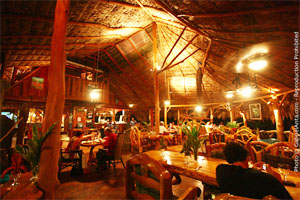 |
|---|
Dining Room at Que Rico Papito |
Some friends and I had the opportunity recently to stay a few days in Puerto Viejo, a fishing village on the caribbean coast of Costa Rica about 40 miles below the city of Limón.
We stayed at La Costa de Papito Hotel just south of the town center on a beautiful beach called Playa Cocles. This place, both hotel and restaurant, has a truly caribbean flair with a light hearted and friendly staff. They bill themselves as "Bungalows for the Noble Savage". Savages should have it so good.
The hotel restaurant is called Que Rico Papito and the dining room is an expansive chamber totally constructed of wood with a thatch roof. The chairs are particularly interesting, being crafted out of thick wood with the backs made from the crotches of tree branches, each chair back having a different shape. The chairs, though extremely heavy are easily mobile because they're on rollers and they're also cushioned, a touch particularly appreciated by the golden one's weak back. The lighting is subdued but adequate and plays against all the wood warmly. The tables are simply decorated and with candle. We give Que Rico Papito five sloths for ambiance.
The menu the first evening we were there was a short but interesting list which featured several seafood options including a lobster in Hawaiian sauce; didn't try it - have to go back. Instead, GG chose a marlin steak topped with a thin layer of swiss cheese and covered with a shrimp-containing bechamel sauce. The marlin was accompanied by a small ring of jasmine rice and a mound of salad greens. The overall effect was like a kind of caribbean casado and was delicious. Other ROMEO's had similar dishes and all reported the food to be fresh, tasty and well presented. GG went for the desert of the day, a caribbean lime pie drizzled with chocolate sauce. What can I say, it's a tough life but we do the best we can. |
 |
|---|---|
$$$ |
|
Value Index = 150 |
We also had breakfasts there as part of out hotel package and breakfast was always good and included omelets made to order as well as fresh tropical fruit. For food quality we give Que Rico Papito four sloths.
Service from the staff, both hotel and restaurant, during out stay there was always friendly, timely and helpful. As an overall rating for ambiance, food quality and service we gladly give Que Rico Papito four and a half sloths.
The bill for my meal consisting of the marlin, lime pie and a soft drink was less than 10,000 colones or just this side of $20. That's a 3 dollar expense rating that puts the restaurant in the lower half of our ratings based on the Quepos/Manuel Antonio standard. It also puts the restaurant in the top third of our "Value Index" system (actually #2 on our current list of 31).
If you're in the Puerto Viejo area, don't fail to stop for a good meal at Que Rico Papito.
don Beto de Quepos, El Gringo Dorado Pura Vida! |
Be pithy but kind. I'm sensitive. |
|---|
